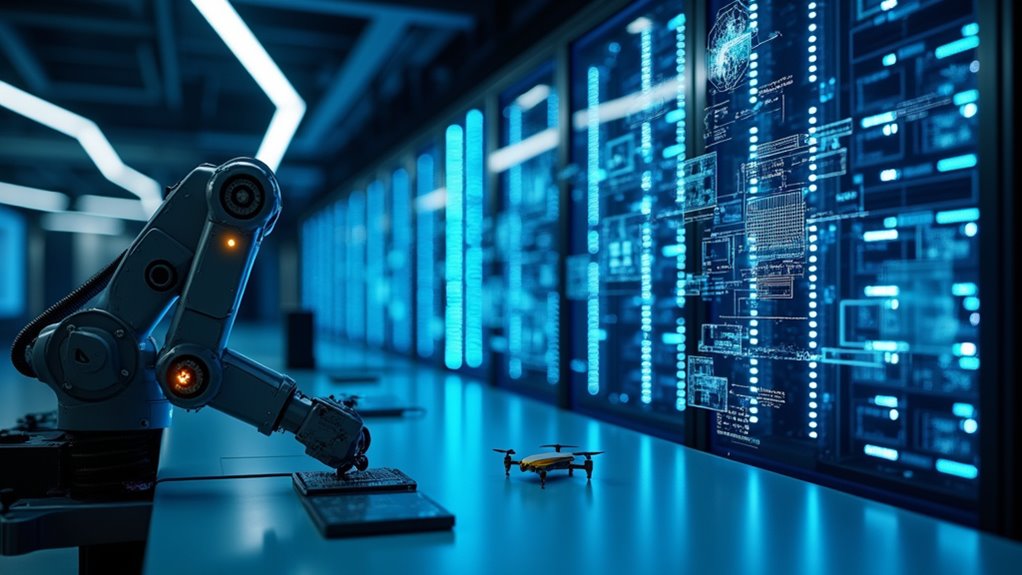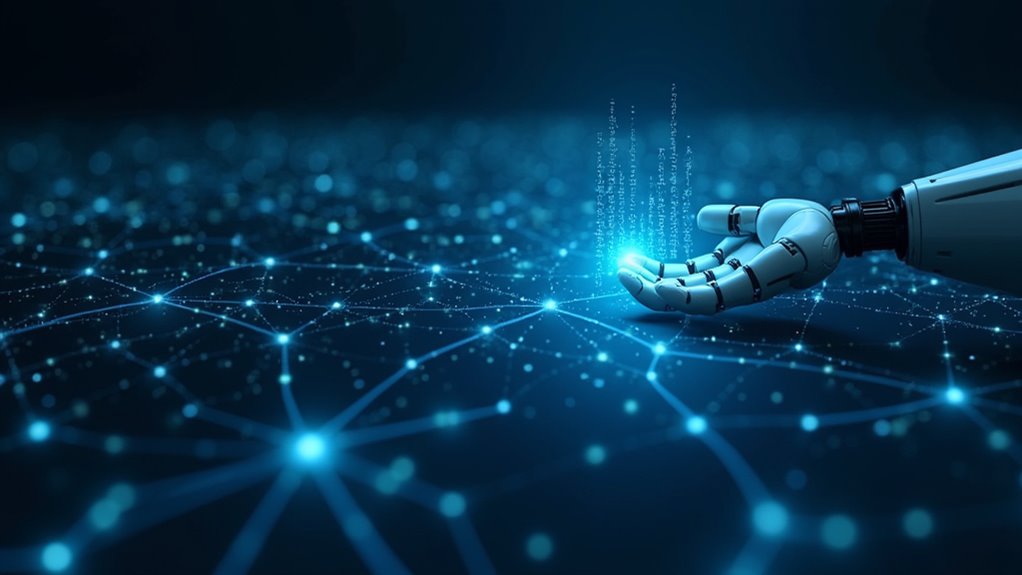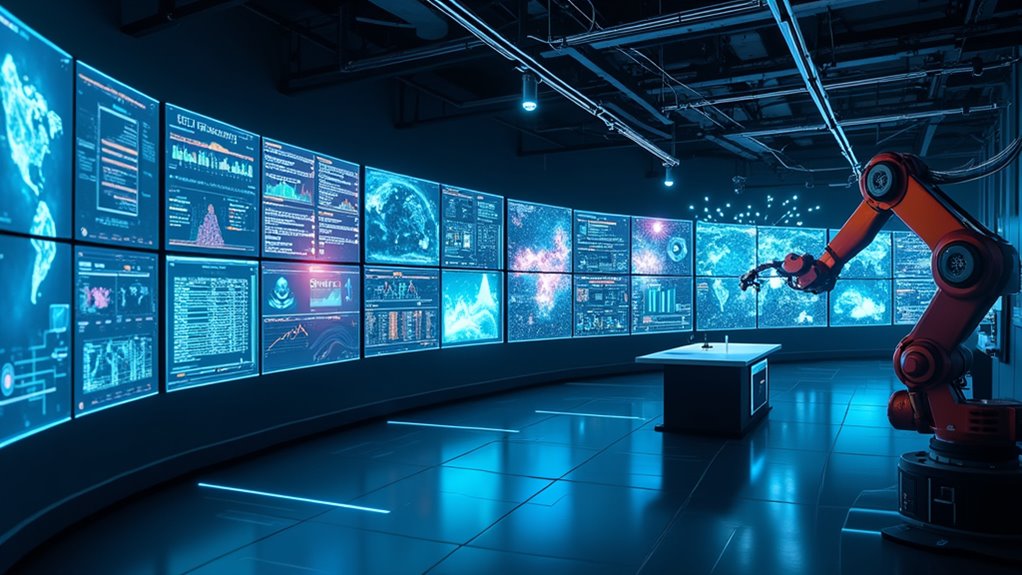Artificial intelligence techniques power today’s tech landscape through four essential methods. Machine learning algorithms improve with experience, while natural language processing lets computers understand your texts and commands. Computer vision interprets visual data like a human eye, and deep learning mimics brain neural networks for complex pattern recognition. Nearly 40% of companies now leverage these technologies for everything from healthcare diagnostics to fraud detection. Discover how these techniques are reshaping industries and creating tomorrow’s job market.

In today’s tech landscape, Artificial Intelligence (AI) stands as a towering colossus, reshaping everything it touches. This transformative technology isn’t magic—it’s powered by sophisticated techniques that enable machines to mimic human-like responses and capabilities. At its core, AI depends on massive datasets that fuel its learning processes, allowing systems to improve without explicit programming. You’ve probably interacted with AI today without even realizing it.
Machine learning represents the backbone of modern AI implementation, with algorithms that actually improve themselves through experience. Yes, they literally get smarter the more they work—unlike some colleagues you might know.
Natural language processing, another cornerstone technique, is why your smart speaker understands when you mumble “Set timer for pasta” at 11 PM. These systems analyze, interpret, and generate human language in useful ways, transforming how we interact with technology. Don’t be fooled by their occasional mix-ups; these systems process language complexities that would make your high school grammar teacher’s head spin.
Computer vision enables machines to “see” and interpret visual information—a capability driving everything from facial recognition to medical imaging analysis. Deep learning, an extension of machine learning using neural networks, handles incredibly complex data patterns. AI’s use of quantum bits dramatically increases storage capacity while reducing processing times compared to traditional computing methods. Think of it as machine learning on steroids, but legal and with fewer side effects.
Industries across the board are being revolutionized by these AI techniques. Healthcare professionals now have AI assistants for diagnoses. Financial institutions detect fraud in milliseconds. Manufacturing plants operate with superhuman precision. Nearly 40% of companies have already jumped on the AI bandwagon, and the NLP market specifically is set to explode by 2030. The integration of AI aims to enhance human capabilities while improving organizational decision-making processes. Modern marketing has been completely transformed through predictive analytics that forecast customer behavior and preferences with remarkable accuracy.
The future brings both promise and caution. While AI techniques will continue automating routine tasks, they also create new job categories we haven’t imagined yet. The most pressing concerns? Data privacy, ethical decision-making, and responsible implementation.
Master these AI techniques now—they’re no longer optional for tomorrow’s technology landscape.
Frequently Asked Questions
How Will AI Impact Job Markets in the Next Decade?
AI will notably reshape job markets through substantial job displacement and skill transformation.
Expect up to 300 million jobs affected globally, with routine tasks automated first.
Don’t panic though! New roles in AI development, data analysis, and cybersecurity will emerge.
Workers must adapt, developing meta skills like creativity and empathy that machines can’t match.
Economic growth could increase by 7% globally, but prepare for growing wage inequalities and regional disparities.
The future demands continuous learning—adapt or get left behind!
What Ethical Frameworks Govern AI Development Internationally?
Internationally, AI development operates under a patchwork of ethical frameworks—each with their own flavor of moral hand-wringing.
The IEEE emphasizes “ethics by design,” while the EU obsesses over fundamental rights and privacy.
Meanwhile, the OECD pushes for innovation with accountability.
Good luck maneuvering through these global regulations!
Countries can’t even agree on basic ethical considerations, creating a regulatory maze that developers must traverse.
Want consistency? You’ll need to wait for the AI overlords to arrive first.
How Do Small Businesses Implement AI on Limited Budgets?
Small businesses implement AI despite budget constraints by prioritizing smart resource allocation.
They leverage cost-effective solutions like off-the-shelf AI tools and free cloud-based options for immediate automation benefits.
Starting with pilot projects keeps risks low while delivering competitive advantage.
The savvy ones? They focus implementation strategies on efficiency-boosting functions first—customer service chatbots or inventory management—before scaling up.
No need for Fortune 500 budgets when you’re strategic about which AI capabilities actually drive ROI.
Can AI Systems Develop Consciousness or Self-Awareness?
Current machine learning systems remain fundamentally unconscious.
Despite advances in cognitive computing, AI lacks the integrated feedback loops and embodied experiences necessary for true self-awareness. Researchers theorize consciousness requires more than just processing power—it needs physiological responses and a global workspace architecture that AI simply doesn’t have.
Could future systems evolve toward consciousness? Maybe, but for now, your smart speaker isn’t secretly judging your playlist choices.
We’re still far from machines that genuinely know they exist.
What Security Measures Protect Against Ai-Based Cyber Attacks?
Protecting against AI-based cyber attacks requires multiple defense layers.
Robust AI security systems detect anomalies in network behavior, while data encryption keeps sensitive information locked away from prying algorithms.
User authentication with multi-factor verification serves as the first line of defense—no password, no party!
Threat detection tools constantly monitor for unusual patterns, and attack mitigation strategies respond automatically when breaches occur.
Organizations building cyber resilience must update these measures regularly because, frankly, hackers never take vacations.









